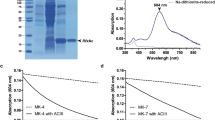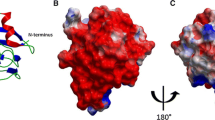Abstract
The crystal structure of Cnx1G, an enzyme involved in the biosynthesis of the molybdenum cofactor (Moco) in Arabidopsis thaliana, revealed the remarkable feature of a copper ion bound to the dithiolene unit of a molybdopterin intermediate (Kuper et al. Nature 430:803–806, 2004). To characterize further the role of copper in Moco biosynthesis, we examined the in vivo and/or in vitro activity of two Moco-dependent enzymes, dimethyl sulfoxide reductase (DMSOR) and nitrate reductase (NR), from cells grown under a variety of copper conditions. We found the activities of DMSOR and NR were not affected when copper was depleted from the media of either Escherichia coli or Rhodobacter sphaeroides. These data suggest that while copper may be utilized during Moco biosynthesis when it is available, copper does not appear to be strictly required for Moco biosynthesis in these two organisms.










Similar content being viewed by others
Notes
Briefly, Kuper et al. purified Cnx1E from A. thaliana with its MPT-AMP intermediate and incubated it with MgCl2 and Na2MoO4 in either the presence or the absence of CuCl2. They then used the nit-1 assay (the in vitro activity of NR from Neurospora crassa [18]) as a probe to infer the ability of copper to inhibit the insertion of molybdenum into MPT to form Moco.
Optical densities were obtained at the end of the growth period (Fig. S5). The OD600 value was essentially unaltered by the presence (standard Sistrom’s medium) or absence (treated with 100 μM BCS) of copper in the growth medium.
The fact that ubiquinol oxidase and cytochrome c oxidase still had measurable (albeit very low) activities despite the extraordinary lengths we went to in order to remove it highlights the difficulty of truly removing trace copper.
Abbreviations
- BCS:
-
Bathocuproine disulfonic acid
- DMS:
-
Dimethyl sulfide
- DMSO:
-
Dimethyl sulfoxide
- DMSOR:
-
Dimethyl sulfoxide reductase
- GC:
-
Gas chromatography
- ICP:
-
Inductively coupled plasma
- LB:
-
Luria–Bertani
- MDH:
-
Malate dehydrogenase
- MGD:
-
Molybdopterin guanine dinucleotide
- Moco:
-
Molybdenum cofactor
- MPT:
-
Molybdopterin
- MPT-AMP:
-
Adenylylated molybdopterin
- NR:
-
Nitrate reductase
- WT:
-
Wild-type
References
Enemark JH, Cosper MM (2002) Met Ions Biol Syst 39:621–654
Hille R (1996) Chem Rev 96:2757–2816
Stiefel EI (2002) Met Ions Biol Syst 39:1–29
Burgmayer SJN (2004) Prog Inorg Chem 52:491–537
Dobbek H, Huber R (2002) Met Ions Biol Syst 39:227–263
Schindelin H, Kisker C, Rajagopalan KV (2001) Adv Protein Chem 58:47–95
Mendel RR, Schwarz G (2002) Met Ions Biol Syst 39:317–368
Magalon A, Frixon C, Pommier J, Giordano G, Blasco F (2002) J Biol Chem 277:48199–48204
Nichols J, Rajagopalan KV (2002) J Biol Chem 277:24995–25000
Nichols JD, Rajagopalan KV (2005) J Biol Chem 280:7817–7822
Llamas A, Mendel RR, Schwarz G (2004) J Biol Chem 279:55241–55246
Kuper J, Llamas A, Hecht H-J, Mendel RR, Schwarz G (2004) Nature 430:803–806
Llamas A, Otte T, Multhaup G, Mendel RR, Schwarz G (2006) J Biol Chem 281:18343–18350
Dobbek H, Gremer L, Kiefersauer R, Huber R, Meyer O (2002) Proc Natl Acad Sci USA 99:15971–15976
George GN, Pickering IJ, Yu EY, Prince RC, Bursakov SA, Gavel OY, Moura I, Moura JJG (2000) J Am Chem Soc 122:8321–8322
Hegg EL (2004) Acc Chem Res 37:775–783
Golden ML, Whaley CM, Rampersad MV, Reibenspies JH, Hancock RD, Darensbourg MY (2005) Inorg Chem 44:875–883
Nason A, Lee K-Y, Pan S-S, Ketchum PA, Lamberti A, DeVries J (1971) Proc Natl Acad Sci USA 68:3242–3246
Yamamoto K, Ishihama A (2005) Mol Microbiol 56:215–227
Morrison MS, Cricco JA, Hegg EL (2005) Biochemistry 44:12554–12563
Calhoun MW, Lemieux LJ, Thomas JW, Hill JT, Goswitz VC, Alben JO, Gennis RB (1993) Biochemistry 32:13254–13261
Sambasivarao D, Weiner JH (1991) J Bacteriol 173:5935–5943
Palmer T, Santini C-L, Iobbi-Nivol C, Eaves DJ, Boxer DH, Giordano G (1996) Mol Microbiol 20:875–884
Chippaux M, Bonnefoy-Orth V, Ratouchniak J, Pascal M-C (1981) Mol Gen Genet 182:477–479
Rothery RA, Chatterjee I, Kiema G, McDermott MT, Weiner JH (1998) Biochem J 332:35–41
Guigliarelli B, Magalon A, Asso M, Bertrand P, Frixon C, Giordano G, Blasco F (1996) Biochemistry 35:4828–4836
Pappas CT et al (2004) J Bacteriol 186:4748–4758
Eraso JM, Kaplan S (2000) Biochemistry 39:2052–2062
Jones RW, Garland PB (1977) Biochem J 164:199–211
Zinder SH, Brock TD (1978) J Gen Microbiol 105:335–342
Ragan CI, Wilson MT, Darley-Usmar VM, Lowe PN (1987) In: Darley-Usmar VM, Rickwood D, Wilson MT (eds) Mitochondria: a practical approach. IRL, Oxford, pp 79–112
Watmough NJ, Katsonouri A, Little RH, Osborne JP, Furlong-Nickels E, Gennis RB, Brittain T, Greenwood C (1997) Biochemistry 36:13736–13742
Zinder SH, Brock TD (1978) Arch Microbiol 116:35–40
Huffman DL, O’Halloran TV (2001) Annu Rev Biochem 70:677–701
Nittis T, McCall K, Winge DR (2001) Mitochondrial copper ion transport. In: Winkelmann G (ed) Microbial transport systems. Wiley-VCH Verlag, New York, pp 419–445
Carr HS, Winge DR (2003) Acc Chem Res 36:309–316
Mendel RR (2005) Dalton Trans 3404–3409
Pau RN, Lawson DM (2002) Met Ions Biol Syst 39:31–74
Rutherford JC, Bird AJ (2004) Eukaryot Cell 3:1–13
Van Ho A, Ward DM, Kaplan J (2002) Annu Rev Microbiol 56:237–261
Schwarz G et al (2004) Hum Mol Genet 13:1249–1255
Acknowledgements
We thank Robert Gennis (University of Illinois), Joel Weiner (University of Alberta), Samuel Kaplan, (University of Texas Medical School), and Jonathan Hosler (University of Mississippi Medical Center) for the bacterial strains and plasmids listed in the “Materials and methods.” We also thank Dennis Winge (University of Utah) and Matthew Sigman (University of Utah) for use of the ICP spectrophotometer and gas chromatograph system, respectively. Finally, we thank Ralf Mendel (Technical University of Braunschweig) for many helpful discussions and comments. Financial support was provided by the National Institutes of Health (grant GM66236) and by the Research Corporation (grant CS0890). E.L.H. is a Cotrell Scholar of Research Corporation
Author information
Authors and Affiliations
Corresponding author
Electronic supplementary material
Below is the link to the electronic supplementary material.
Rights and permissions
About this article
Cite this article
Morrison, M.S., Cobine, P.A. & Hegg, E.L. Probing the role of copper in the biosynthesis of the molybdenum cofactor in Escherichia coli and Rhodobacter sphaeroides . J Biol Inorg Chem 12, 1129–1139 (2007). https://doi.org/10.1007/s00775-007-0279-x
Received:
Accepted:
Published:
Issue Date:
DOI: https://doi.org/10.1007/s00775-007-0279-x




